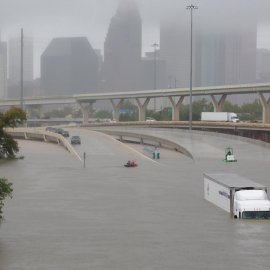Hurricane Harvey and the Future: What Would a New Houston Look Like?
-
English
-
ListenPause
Welcome to World Ocean Radio… I’m Peter Neill, Director of the World Ocean Observatory. The images from Houston, Texas are devastating: of vast areas flooded, of pollution and fire, of destroyed infrastructure, of harrowing tales of rescue, of challenges to re-build almost beyond imagination. The message is that extreme weather, rain, flood, and sea level rise are our enemy. Natural forces unleashed at epic scale are the cause of this devastation and we are their victims. But is that truly the case? Beyond the tragic stories and estimates of loss, what are the questions that must be asked, the lessons to be learned from this catastrophe? Houston is a city based on a 19th century based paradigm of unlimited growth in the name of consumption enabled by fossil fuels; its identity formed by oil, chemicals, port operations, and other manifestations of the industrial revolution. It has grown exponentially with limited planning, regulation, and foresight, reveling in its freedom, a wildcat mentality that has made its citizens wealthy and all our lives better. But that paradigm is now bankrupt, in that the consequences of its application now outweigh the benefits. Houston was not concerned with these consequences of culture – the emissions from its refineries, the leaks from its networked pipelines, the toxic waste from its manufacturing, the inadequacies of its water management and treatments systems, and the potential disaster should anything confront these conditions -- like a hurricane with record rainfall, storm surge, or any other natural climate phenomenon in a rapidly changing world. The question today is not so much explanation or blame as it is on what premises to rebuild. The evidence of the storm and flooding provides an outline for a different, perhaps preventative response, not to re-construct the city as it was, but to redesign the city in the face of what surely will be comparable events to come. What if Houston was to re-organize based on a new 21st century paradigm: managed growth in the name of sustainability enabled by water, the most valuable natural resource on earth. What if Houston rebuilds with this operative paradigm, with water, not as its enemy, but as its friend? What if Houston revives as a “new hydraulic society,” a community that understands that its survival depends on the fresh water/ocean continuum that will drive its economy, sustain its community, and establish its viability into the future? To do so will of course require enormous financial resources, but more importantly enormous political will. The paradox of Houston and Texas politicians asking for billions in federal funds for re-construction is stunning. Not lost on the governors of New Jersey and New York, this understanding should not be lost by all tax-payers nationwide who are being asked ultimately to foot the bill. We should make such a contribution, but not to rebuild Houston as its former self. The lessons of storms like Katrina and Sandy must not be ignored and we should no longer support reconstruction that will not address the fundamental realities of this changing world. What would a new Houston look like? Well, the destruction itself suggests a plan. The location of buildings and residences; industrial, refining, and water treatment facilities; highways and bridges; reservoirs and parks can be reviewed in the context of this evidence. New building codes, directed zoning, different construction materials, civil engineering and modern technology, design criteria and reviews can be revised and applied to facilitate such transformation immediately. Directed reconstruction funds, municipal bonds, subsidies, tax incentives, and other more creative financial instruments can be brought to bear on the realization of a city re-envisioned and reborn. The understanding of how water moves can inform its collection, diversion, utility, and protection, turning water into a positive catalyst for the invention of a new city, redirected and revivified by water, aligned with the forces of Nature, integrated by a new idea of commonality and community, and prepared to meet the challenges of a new century and sustainable future. Hydraulic society is not a new idea. Great civilizations in the past have organized themselves around this essential principle. It was only when they denied changing conditions that they collapsed, often suddenly and completely. Houston’s rebirth could be a turning point in our own civilization now threatened by change, a model for all cities everywhere for how we value, structure, and behave successfully in a new world. Water is essential. We live on a water planet. Water is life. Water is not our enemy. Water is the essential element for our future, security, health, equity, and social justice. We should not fear it, but embrace it. We will discuss these issues, and more, in future editions of World Ocean Radio.
Natural forces unleashed an epic scale of destruction on Houston and surrounding areas of Texas. Built upon consumption, unmitigated growth, and fossil fuels, critics now point to the consequences of development based on an outdated paradigm. In this episode of World Ocean Radio, host Peter Neill asks, “What are the questions we should be asking, and what are the lessons to be learned from this catastrophe?” and he suggests a new, reorganizing principle on which to rebuild, one that redesigns in the face of a changing climate future, and one that manages growth and treats water as an asset, not an enemy.
About World Ocean Radio
Peter Neill, Director of the World Ocean Observatory and host of World Ocean Radio, provides coverage of a broad spectrum of ocean issues from science and education to advocacy and exemplary projects. World Ocean Radio, a project of the World Ocean Observatory, is a weekly series of five-minute audio essays available for syndicated use at no cost by college and community radio stations worldwide.
Image
I45, submerged from the effects of Hurricane Harvey, which caused widespread flooding in Houston, Texas and surrounding areas.
Credit
Richard Carson for Reuters (c)
- Login to post comments



